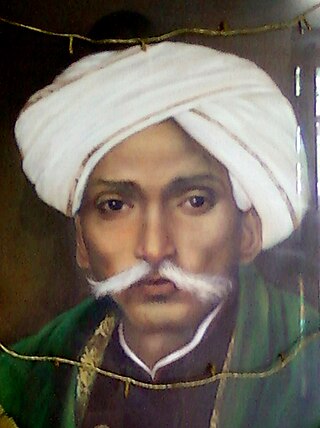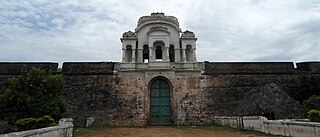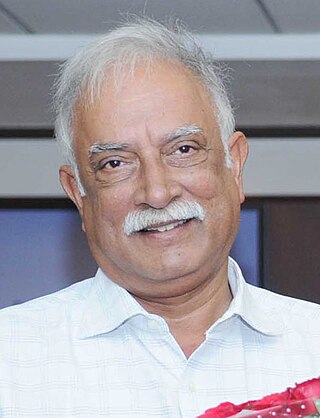
Vizianagaram, also known as Vijayanagaram, is a city and the headquarters of the Vizianagaram district in the Indian state of Andhra Pradesh. It is located in the Eastern Ghats, about 24 km (15 mi) west of the Bay of Bengal and 40 km (25 mi) north-northeast of Visakhapatnam. The city has a population of 228,025 and was established as the capital of the Vizianagaram estate by Raja Vijayaram Raj from the Pusapati dynasty. The rulers had a notable role in the history of the region in the 18th century and were patrons of education and arts.

Gurajada Venkata Apparao was an Indian playwright, dramatist, poet, and writer known for his works in Telugu theatre. Rao wrote the play Kanyasulkam in 1892, which is considered as the greatest play in the Telugu language. One of the pioneers of Indian theatre, Apparao holds the titles Kavisekhara and Abyudaya Kavitha Pithamahudu. In 1910, Rao scripted the widely known Telugu patriotic song "Desamunu Preminchumanna".
The Battle of Bobbili, comprising the attack on the fort of Bobbili on 24 January 1757, was a significant event in the princely state of Vizianagaram. Gen. Tandra Paparayudu gained the sobriquet The Tiger of Bobbili for his fierce, ultimately hopeless resistance, and final vengeance.

Padmanabham mandal is one of the 46 mandals in Visakhapatnam District in India. It is under the administration of Bhemunipatnam revenue division and the headquarters is located at Padmanabham. The Mandal is bounded by Bheemunipatnam, Anandapuram mandals in Visakhapatnam District and Bhogapuram mandal in Vizianagaram District. Great freedom fighter Alluri Sitarama Raju was born in Pandrangi village in this Mandal.Rajasagi Suryanarayana Raju, MLA Bheemili from 1972–78 is from this Mandal. Also Rajasagi Appalanarasimha Raju MLA Bheemili from 1985 to 2004 is also from this Mandal.

Maharaja Pusapati Vijayrama Gajapati Raju D.Litt. was an Indian parliamentarian and philanthropist. He was the eldest son of Maharaja Alak Narayanadev Gajapathi Raju and Vidyavathi Devi of Vizianagaram estate in Andhra Pradesh. He was born at Phool Bagh Palace in Vizianagaram.

North Andhra or Uttara Andhra, also known as Kalinga Andhra, is a geographic region in the Indian state of Andhra Pradesh. It is between the Eastern Ghats and the coast of the Bay of Bengal. It comprises six northern districts of the state, Srikakulam, Parvathipuram Manyam, Vizianagaram, Visakhapatnam, half of the Alluri Sitharama Raju district and Anakapalli. Alluri Sitharama Raju district was carved out of Erstwhile Visakhapatnam and East Godavari districts. So, half of the Alluri Sitharamaraju district belongs to North Andhra/ Uttara Andhra and the southern part of this district belongs to Coastal Andhra region/ Godavari region. As of 2011 census of India, the region with six districts has a population of 9,338,177.
Poosapati / Pusapati was the ruling clan of the Vizianagaram estate.
Simhadri Narasimha Satakam is a compilation of Telugu poems by Gogulapati Kurmanatha Kavi in the 18th century. He wrote the Satakam extempore in praise of Lord Varaha Narasimha of Simhachalam.

Maharajah's College, or M. R. College, established in 1879, it is an autonomous institution located in Vizianagaram, Andhra Pradesh.
Maharajah's Government College of Music and Dance is an educational institution in Vizianagaram, Andhra Pradesh, India. It is the first music college in South India.

The name is derived from its founder Raja Vijayaram Raj who established a sovereign kingdom by claiming independence from the Kingdom of Jeypore in 1711. It formed alliances with the French and British East India Company to conquer the neighbouring principalities of Bobbili, Kurupam, Paralakhemundi and the Kingdom of Jeypore. However, they fell out with the British and as a result were attacked and defeated in the Battle of Padmanabham. They were annexed as a tributary estate like other principalities and remained so, until their accession to the Indian Union in 1949.
Uma Gajapathi Raju is an Indian politician and a former member of Indian Parliament. She was born at Palghat, Kerala on 17 November 1953. She was educated at Madras University. She married Pusapati Ananda Gajapathi Raju on 18 August 1971. They had 2 daughters. They divorced in 1989 and she married film maker Ramesh Sharma in 1991. Anand Ganapathi Raju died in 2016.

Tandra Paparayudu was an Army General of Bobbili who assassinated Pusapati Vijayarama Gajapati Raju I Raja of Vizianagaram, and committed his Royal suicide during the Battle of Bobbili in 1757, a significant historical event in the Princely state of Vizianagaram, the present day Vizianagaram district of Andhra Pradesh.

Pusapati Ashok Gajapathi Raju is an Indian politician and the former Union Minister for Civil Aviation in the Narendra Modi Government. A scion of royal family of Vizianagaram princely state, he is the younger son of the last Maharaja of Vizianagaram. He was a member of Andhra Pradesh State legislature for over twenty five years and was a Minister in the Govt. of A.P., for thirteen years holding the portfolios of Commercial Tax, Excise, Legislative affairs, Finance, Planning and Revenue.

Vizianagaram fort is an early 18th-century fort in the city of Vizianagaram in northeastern Andhra Pradesh, South India. It was built by Vijaya Rama Raju, the Maharaja of Vizianagaram in 1713. The formal ceremony, while laying the foundation for the fort, was very auspicious as it represented five signs of victory. The square-shaped fort has two main gates, of which the main entry gate has elaborate architectural features. There are many temples and palaces within the fort and a victory tower. This alternative name is Pusapati.
Kolluri Kamasastry (1840–1907) was a Sanskrit scholar. He was a poet who adorned in Vizianagaram Pusapati Ananda Gajapati Raju Maharaja's court. He translated many Sanskrit books into Telugu language. "Andhra dharma Sindhu" and "Sudra Kamalakaramu" are his two most important translations in to Telugu. He was also the author of "Raghunayaka Satakamu".
Gurajada Srirama Murty (1851–1899) was Telugu writer, poet and editor. He published his book on the lives of the Telugu poets in the last decade of the nineteenth century, the trend has been set for the writing of biography in Telugu.
Jagannatha Gajapati Narayana Deo II was the Odia monarch of the Paralakhemundi Estate in the southern part of today's Odisha and northern Andhra Pradesh. He was from the Eastern Ganga dynasty of the Khemundi Ganga Branch from the year 1736 CE to 1771 CE. He had ascended to the throne at the age of eighteen and at a time when Odisha was torn apart due conflicts between external powers like the Mughals, Marathas, French and British for control of the territory. He invaded khurdha Bhoi dynasty king Birakishore Deva and Vizianagaram estate King Pusapati Vijayarama Raju II and defeated the both kings. He made the last great attempts on his own to revive the lost glory of Odisha and its unique Hindu culture that revolved around the tradition of Jagannath worship. He had defied the authority of the Nizam of Hyderabad and maintained his own sovereignty. He was one of the first rulers who indulged in conflicts with the new European colonists in the eastern part of India. He was also effort bound till the end of his life in framing strategic diplomatic plans to free the ancient land of Odisha from external aggressors and revival of its lost Eastern Ganga Dynasty-Gajapati glory from the past.

Pusapati Ananda Gajapati Raju Vijayanagaram Pusapati royalist, former minister, Chairman of Mansa Trust.
Calamur Chandrasekhara Sastri (1854–1887), sometimes Sastry or Sastriyar, was the first Principal and Professor of English and Sanskrit of the Maharajah's College at Vizianagaram from his appointment in 1875, developing it from a secondary school with four teachers into a graduate institution before his death at the age of 32 in 1887, with the support of the contemporaneously reigning Maharajas of Vizianagaram, Pusapati Vijayarama Gajapathi Raju III and Pusapati Ananda Gajapati Raju. He was the first Indian principal of any South Indian college at the time.













